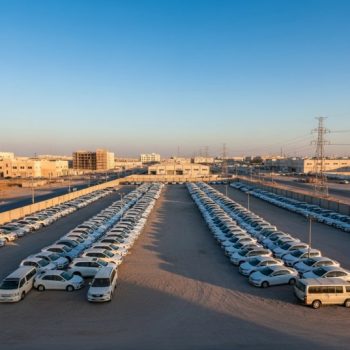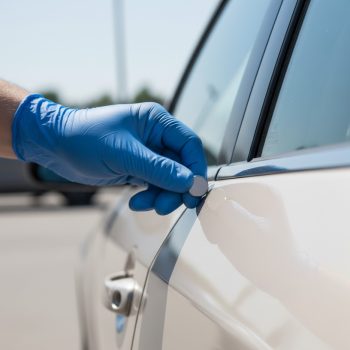Smart Expat’s Guide: Buying a Used Car in Mussafah
Buying a used car in Mussafah can feel overwhelming. The area has hundreds of dealerships selling thousands of cars, but not all of them are honest about what they’re selling. As an expat in Abu Dhabi, you need to know what to look for before you hand over your money.
Mussafah Industrial Area is the biggest used car market in Abu Dhabi. You’ll find dealerships all along the main roads, offering everything from budget sedans to luxury SUVs. But here’s the problem: the extreme desert heat, aggressive driving, and occasional flooding mean many of these cars have hidden damage that sellers try to hide.
Before you buy that “barely used” car or “lady-owned” SUV, you need to know exactly what you’re looking at. This isn’t just about checking if the engine starts. It’s about finding the damage that Abu Dhabi’s tough conditions leave behind. When you later need a reliable car service in Mussafah center, you’ll want to be sure your purchase won’t need thousands of dirhams in immediate repairs.
Let’s go through the inspection checklist that will help you avoid expensive mistakes.
Understanding Mussafah’s Used Car Market
Mussafah is Abu Dhabi’s go-to place for used cars. You’ll find major dealers like Al Masaood Automobiles in the M12 and M46 areas, plus Toyota and Nissan showrooms throughout the industrial zone. The huge selection creates good prices, but it also attracts dishonest sellers.
Desert conditions damage cars differently from normal weather. The extreme heat – temperatures often go above 45°C in summer – and fine sand create unique problems for cars. According to a 2024 Ministry of Interior report, 43 percent of all car fires in the UAE happened because of extreme summer heat. Over 2,189 cars caught fire in Abu Dhabi and Dubai last year during the heatwave when temperatures hit 52°C.
The used car market changed a lot this year. More expats started looking at certified pre-owned cars to save money. Average prices for used cars in Abu Dhabi range from AED 5,000 to AED 1,350,000, depending on the make, model, year, and condition.
Pro Tip: Visit Mussafah dealerships on weekday mornings when it’s less crowded. You’ll have more time to inspect cars properly without feeling rushed. Weekends get very busy, making detailed inspections difficult.


Do Your Homework Before You Visit
Smart buyers start investigating before they even go to Mussafah. This research saves time and helps you spot problems immediately.
Get the Complete Vehicle History
Ask for the Vehicle Identification Number (VIN) right away. Honest sellers give this to you immediately. If they hesitate, that’s a warning sign. The RTA Vehicle Status Certificate costs AED 100 and shows important information, including insurance history, previous owners, and the car’s condition during yearly inspections.
You can get this through the official RTA website under Driver & Car Owner Services. You’ll need the current owner’s permission – they get an SMS code to approve the report. This protects vehicle owners’ privacy, but honest sellers shouldn’t have any problem with it.
For imported cars, the service connects with international companies like CARFAX America and European AUTO DNA Services to get full histories from America, Europe, and Asia for an extra fee.
Check Official Accident Records
Several government websites let you check accident history for free. The Emirates Vehicle Gate website lets you search by chassis number to see every reported accident, including where it happened, what type it was, and how bad the damage was. Abu Dhabi Police’s e-Services portal has similar information under Vehicle Accidents Inquiry.
According to the UAE’s Civil Transactions Law, sellers must tell you about any known problems with the car, including if someone rolled back the odometer or if it was in accident. If you find hidden problems within six months of buying, you can legally cancel the contract and get your money back. Article 555 extends this protection beyond six months if the seller gave you specific guarantees.
Important: Not every accident gets officially reported. Small parking lot bumps or private settlements won’t show up in government databases. This makes physical inspection absolutely necessary.
Check Service History Papers
Ask for all service books and maintenance receipts. Real documentation shows consistent mileage increases with dates and stamps from authorized service centers. According to odometer fraud detection methods, comparing mileage on service records with the current reading shows if someone tampered with it.
A car that’s about five years old should have more than 50,000 kilometers on it. Much lower readings should make you suspicious – either the car barely got used (possible but rare) or someone rolled back the numbers. On certain models, an asterisk next to the odometer numbers shows when readings have been changed.
Checking for Desert Climate Damage
Abu Dhabi’s environment damages cars in ways that cooler climates don’t. Your inspection needs to specifically check for these unique problems.
Heat Damage in the Engine Bay
Open the hood and look beyond how clean everything looks. Extreme heat makes fluids evaporate faster and damages materials. Check coolant levels when the engine is completely cool – low levels or murky liquid mean neglect or possible leaks.
Look at rubber hoses and drive belts for heat-related cracks, brittleness, or unusual hardness. These parts wear out faster in the UAE’s climate. According to cooling system maintenance guidelines, you should flush coolant every two years or 40,000 kilometers, whichever comes first. Ask when the last flush happened.
Check the radiator and condenser for sand buildup blocking airflow. Clogged cooling systems lead directly to overheating – one of the most common problems in summer. Look for rust around the radiator, thermostat housing, and water pump areas that show cooling system leaks.
Engine oil condition tells you about maintenance history. Pull the dipstick and check the oil color and thickness. Fresh oil looks amber or light brown. Black, gritty oil means they waited too long between oil changes. If the oil looks murky or milky like melted ice cream, water got in – this means serious engine problems, possibly flood damage, or head gasket failure.


Air Conditioning System Check
In Abu Dhabi, working AC isn’t a luxury – it’s essential. Test the system thoroughly during your inspection. Turn the AC to maximum cold with the fan on high. Within two minutes, the vents should blow genuinely cold air, not just cool.
High temperatures make AC refrigerant less effective at cooling. Low refrigerant levels or leaks in the system hurt cooling ability. Poor insulation lets hot outside air in, making it harder to keep the cabin cool.
Listen for unusual noises when the AC turns on. Grinding, squealing, or clicking sounds mean the compressor is failing. Check that all vents throughout the car deliver consistent airflow – weak spots mean blocked ducts or failing blower motors.
Pro Tip: Even in summer, turn on the heater briefly. This tests the heating core and makes sure the full HVAC system works. It seems strange, but turning on the heater can actually help cool down an overheating engine by pulling heat from the engine bay into the cabin.
Battery Health Check
Heat is a battery’s worst enemy. High temperatures make fluid evaporate inside the battery and speed up internal rust. Batteries over 2-3 years old in the UAE often need replacement, even if they still work.
Check battery terminals for white, green, or blue rust buildup. Clean terminals show proper maintenance. Ask when the battery was last tested or replaced. Many sellers install cheap batteries just before selling – these might fail within months.
If possible, ask for a battery load test at a nearby service center. Most shops do this quickly and cheaply. The test shows whether the battery holds a proper charge under stress. Weak batteries will fail without warning, leaving you stuck.
Finding Hidden Accident Damage
This is where most buyers get fooled. Professional body shops can make severe crash damage almost invisible to untrained eyes. You need to be systematic to find the truth.
The Paint Thickness Test
Bring a small magnet with you. Place it on different body panels – hood, fenders, doors, and roof. Real steel panels should attract the magnet strongly (95 percent or more). Weak attraction means body filler underneath the paint, used to hide crash damage.
Professional inspectors use digital paint thickness gauges like the Elcometer 311 Automotive Paint Meter, which can take 60+ readings per minute to find hidden repairs, impact damage, and filled body panels. These devices instantly recognize whether they’re measuring steel or aluminum panels – important for luxury cars using mixed materials.
Very high or very low thickness readings show where previous repairs happened. Factory paint usually measures within specific ranges depending on the manufacturer. Repairs usually show measurements 2-3 times thicker because of filler and extra paint layers.
Visual Alignment Check
Stand at each corner of the car and look down the body panels. Consistent gaps between doors, fenders, hood, and trunk mean original factory assembly. Uneven spacing, wider gaps on one side, or misaligned panels mean reconstruction after a crash.
According to GCC Standard 456-7 for lifted vehicles popular in desert driving, frame misalignment over 3 millimeters means significant past damage affecting safety and performance. For regular sedans and SUVs, any visible misalignment is concerning.
Look at the headlight and taillight assemblies carefully. Check production dates stamped on both headlights – they should match. Different dates mean replacement after an accident. Look inside light fixtures for water lines, moisture drops, or fogging on the inside of the lenses. While bad seals can cause this, multiple affected lights mean the car was underwater.
Interior Warning Signs
Serious accidents leave traces inside the car that sellers can’t easily remove. Check seatbelts by pulling them all the way out and seeing if they retract smoothly. Difficulty retracting means internal rust from water exposure or impacts that damaged the mechanism.
Look at the dashboard and door panels for water lines – faint discoloration marks at the same height. These show the maximum water level if the car were in a flood. Look under floor mats and inside the glove box for dirt deposits, mud, or unusual staining.
Lift carpeting wherever possible, especially in the footwells and trunk. Feel the carpet backing and padding underneath. Surface carpet dries quickly, but foam padding stays damp for years. A damp, musty, or crumbly texture means flood exposure. A persistent moldy or musty smell in the cabin, even if the interior looks dry, confirms water damage.


Spotting Flood-Damaged Cars
The UAE gets occasional heavy rain and flash flooding, especially in low areas. Flood-damaged cars often get cosmetic repairs and go back on the market. These cars develop constant electrical problems, rust, and mechanical failures.
Outside Flood Signs
Look under the car for signs of rust, caked mud, or debris around the bottom, suspension parts, exhaust system, and oil pan. Recent cleaning or fresh paint on the underside parts should make you suspicious – why would someone pay for cosmetic underbody work unless they’re hiding something?
According to flood damage detection methods, checking for tiny drilled holes in door panels or underbody areas can show previous water drainage attempts. Floodwater trapped inside door cavities must drain somehow, and dishonest repairers drill hidden holes rather than properly drying the car.
Look at door panels for warping, detachment, bubbling around seals, or loose trim pieces. Water getting in causes the door panel swelling and separation. Check that all door rubbers and weatherstripping look consistent and properly seated.
Under-Hood Flood Evidence
Open the hood and check hard-to-reach areas around the engine bay, behind the battery, near the firewall, and around the air intake. Look for mud trails, dirt deposits, or water-carried debris that stays after cleaning attempts.
Pull the engine air filter and look at it closely. According to pre-purchase inspection protocols, once paper filter elements get wet, they never look the same. Water stains or unusual discoloration mean it was underwater. Think of it like those moisture indicators in cell phones that turn pink when exposed to water.
Check the oil dipstick again, specifically for milky appearance or foam. This mixing happens when water enters the engine. Even after oil changes, traces often remain. Check transmission fluid via its dipstick if you can reach it – contaminated transmission fluid looks milky or shows bubbles.
Electrical System Red Flags
Flood damage mainly destroys electrical systems. Floodwater can damage or short-circuit electrical parts, leading to problems in everything from the lights and power windows to the engine control unit.
During your test drive, test every electrical part methodically. Turn headlights, high beams, turn signals, and hazard lights on and off several times. Make power windows go up and down repeatedly – hesitation or slow movement means motor damage. Test all door locks, including central locking. Check that the screen boots properly without glitches.
Speakers have paper cones inside. Water-damaged speakers produce distorted sound or fail completely. Play audio at different volume levels through all speakers. Listen for crackling, buzzing, or muffled output that shows moisture exposure.
The Odometer Fraud Reality
According to many drivers who have been victims of odometer fraud, dealers get away with this because none of the vehicle inspection centers in the city detect odometer tampering. This remains a big problem in the UAE’s used car market.
Digital Tampering Detection
Modern cars store mileage data in multiple Electronic Control Units (ECUs), not just the instrument cluster. Authorized dealerships can detect tampering by connecting diagnostic equipment that shows mileage differences between different modules. For brands like BMW, mileage data is even stored on both key fobs, making fraud easier to detect.
Ask for a diagnostic scan at the brand’s authorized service center. Most charge small fees for this service. The scan shows true ECU-stored mileage and whether anyone accessed or changed the cluster. According to automotive service protocols, diagnostic tools show clear evidence when someone has reprogrammed the instrument cluster.
Physical Wear Pattern Analysis
Compare the claimed mileage against visible wear on high-contact surfaces. Look at the brake and accelerator pedals closely. For manual transmissions, check clutch pedal wear. Pedals on truly low-mileage cars show minimal rubber wear and keep clear surface patterns. Worn, smooth, or polished pedals contradict low odometer readings.
Study the driver’s seat condition. Check for creasing, cracking, side wear, or sagging that develops after thousands of hours of use. The steering wheel rim also reveals truth – leather or coating wear on the hand positions shows extensive driving time.
Look at the gear shift lever and surrounding trim for wear patterns. High-mileage cars show polished areas where hands repeatedly touch surfaces. Check door handle interiors, window switches, and commonly touched controls for finish wear that contradicts claimed mileage.
Service History Cross-Check
Compare the odometer reading against documented service records. Each service entry should list mileage and dates. Plot these points in order – genuine patterns show steady increases matching the car’s age. Sudden drops, missing periods, or inconsistent patterns expose tampering.
According to a Carswitch case study, comparing current odometer readings with mileage from RTA annual inspection records helps detect fraud. Each year’s inspection certificate documents the mileage. Big differences between consecutive years, especially decreases, confirm odometer rollback.
Average yearly mileage in Abu Dhabi ranges from 10,000-15,000 kilometers for typical drivers. Lower-mileage cars exist – housewives with multiple cars, company fleet vehicles with limited use, or cars used only for short trips. But extremely low readings on older cars need extra verification.
Professional Inspection Services: Worth the Money
Even with this detailed knowledge, hiring professional inspectors gives you extra security. They bring specialized equipment, manufacturer-specific technical knowledge, and experience spotting issues that untrained people miss.
Certified technicians do engine compression tests showing internal wear or damage. They do leak-down tests showing where compression escapes – worn piston rings, valves, or head gaskets. These tests predict remaining engine life accurately.
Transmission checks include road testing to detect hard shifting, slippage, or fluid contamination. Clutch assessments measure remaining clutch plate thickness on manual transmissions. For automatics, inspectors check the torque converter and flexplate conditions.
Suspension part examinations identify worn shocks, struts, control arms, bushings, and ball joints before they fail. Brake system checks measure pad thickness, rotor condition, caliper operation, and hydraulic line integrity. Many buyers skip these critical safety checks, only finding problems after purchase.
Pro Tip: Schedule professional inspections at the seller’s location in Mussafah for convenience, or ask them to bring the car to your chosen inspection center. Sellers refusing inspections are showing you everything you need to know – walk away immediately.
The Test Drive: Your Final Check
Never skip the test drive, no matter how perfect the car looks sitting still. Real-world driving reveals problems invisible during a stationary inspection.
Cold Start Behavior
If possible, check cars before sellers start them. Cold starts expose problems that warm engines hide. Listen for unusual noises during starting – grinding, clicking, or long cranking means starter motor wear, weak battery, or compression issues.
Watch for excessive smoke from the exhaust when starting. Blue smoke means burning oil from worn piston rings or valve seals. White smoke could mean coolant entering cylinders through a blown head gasket or a cracked block. Black smoke means an overly rich fuel mixture, potentially from faulty sensors or injectors.
On-Road Performance Testing
Find a route covering different conditions – smooth highway, rough roads, stop-and-go traffic, and, if possible, slight hills. This variety stresses different systems.
Speed up quickly from a stop. Hesitation, jerking, or unusual sounds mean drivetrain problems. Manual transmissions should shift smoothly through all gears. Automatics should change seamlessly without harshness, slipping, or delayed engagement.
Test brakes at different speeds. Straight-line stopping without pulling left or right confirms proper brake balance. Pulsating pedals mean warped rotors. Squealing, grinding, or excessive pedal travel signal brake system wear.
Drive over speed bumps and rough surfaces at moderate speeds. Excessive bouncing, knocking sounds, or continued bouncing after bumps show worn suspension parts. Steering should feel responsive without excessive play, vibration, or unusual resistance.
Climate Control Performance
Run both AC and heating during the drive. According to HVAC testing protocols, properly working systems should reach target temperatures within minutes and keep them consistently. Temperature changes or a gradual warm-up mean refrigerant leaks or compressor problems.
Listen for whistling, rattling, or unusual sounds when adjusting fan speeds or temperature settings. These noises mean blocked ducts, failing blend doors, or loose parts.
Desert-Specific Things to Check
Abu Dhabi’s unique environment creates extra checkpoints that don’t apply elsewhere.
Sand and Dust Getting In
Check cabin air filter condition – it shows maintenance care and environmental exposure. Extremely dirty filters in supposedly low-mileage cars contradict seller claims. Dirty filters also reduce AC efficiency and let fine dust into the cabin.
Look at the window and door seals carefully. Sand and dust get in through worn weatherstripping. Look for fine sand buildup in door jambs, around window bases, and in trunk seals. This means either neglected seals or cars frequently driven in harsh off-road conditions.
Off-Road Use Signs
Many Abu Dhabi cars see desert dune driving or beach driving – harsh environments that speed up wear. Look for sand or mud caked in wheel wells, suspension parts, and underbody crevices that cleaning missed.
Check for scratches or dents on underbody panels, skid plates, or differential covers. Rock impacts leave distinctive marks. Look at suspension parts for bent components, unusual wear patterns, or fresh paint covering damaged areas.
Rust From Coastal Proximity
Mussafah sits near coastal areas where salt air speeds up rust. Check all metal surfaces for rust, especially in hidden areas – under fenders, inside door bottoms, around trunk seal areas, and under carpeting where water accumulates.
Look at exhaust system parts for rust holes or corrosion. Salt speeds up exhaust deterioration, creating expensive replacement needs. Check suspension bolts and fasteners for rust that could make future maintenance difficult.
Price Negotiation Strategies
With your inspection findings, you now have negotiation leverage. Smart buyers use documented issues to justify price reductions.
Building Your Case
Take photos of every issue found during inspection. Get quotes for necessary repairs from authorized service centers. For example, AC compressor replacements cost AED 2,000-4,000. Brake system overhauls run AED 1,500-3,000. Engine issues requiring major work start at AED 5,000.
Present repair estimates totaling the costs you’ll face right after purchase. According to negotiation best practices, asking for discounts equal to 120 percent of documented repair costs provides fair leverage while accounting for your inconvenience.
Regional Market Pricing
Check recent sales data from Dubizzle and other platforms showing actual selling prices for similar cars. According to market analysis, used car prices in the UAE change a lot, making current data essential. Filter by make, model, year, mileage, and condition to find accurate comparisons.
If the seller’s asking price is more than 10-15 percent above market average, and inspection shows issues, you have strong grounds for a big reduction. Present your research professionally – emotional negotiations rarely work.
Walking Away Power
Your strongest negotiation tool is being truly willing to walk away. Mussafah has hundreds of dealerships and thousands of cars. If a seller refuses reasonable negotiations or prevents thorough inspection, better options exist elsewhere.
According to consumer protection advice, trust your gut. Sellers using high-pressure tactics, refusing documentation, or giving incomplete answers are signaling problems. Patient, persistent searching eventually finds properly priced, well-maintained cars from honest sellers.
Required Papers Before Purchase
Check that all paperwork is complete and legitimate before transferring any money.
Essential Documents Checklist
- Original Registration Card (Mulkiya): Confirms legal ownership and current registration status. Check that the name matches the seller’s Emirates ID. Check registration expiration date – expired registration needs renewal before transfer.
- RTA Passing Certificate: Shows the car has recently passed the annual technical inspection. Valid certificates have a 30-day validity from the inspection date. Cars failing inspection can’t be registered until repairs are done and retested.
- Insurance Certificate: Current comprehensive or third-party insurance must be active. Check the policy covers the car’s current use and includes expats if applicable. Check policy expiration dates.
- Chassis Number Check: Compare chassis numbers on the Mulkiya, the physical chassis plate on the car, and the windshield VIN sticker. Differences mean potential tampering, stolen vehicles, or documentation fraud.
- Service History Books: Original manufacturer service books show maintenance done at authorized centers. Stamps, dates, mileage, and work descriptions should look consistent and in order.
- Release Letter (if applicable): Cars previously leased or financed need official bank release letters confirming all payments are complete and the bank has no claims on the car.
Transfer Process Requirements
Car ownership transfer in Abu Dhabi requires visiting an approved typing center near RTA facilities. They prepare transfer documents for small fees. Both buyer and seller must attend with Emirates IDs, car registration, passing certificate, and insurance documentation.
Transfer fees vary based on car value. Expect to pay about AED 420 for registration transfer, plus AED 120 for new number plates if changing them. Knowledge and innovation fees add another AED 20.
The entire transfer process usually completes within 1-2 hours if all documentation is proper. Issues with paperwork, failed inspections, or unpaid fines cause delays.
Common Mussafah Buying Mistakes to Avoid
Learn from others’ expensive errors and avoid these pitfalls.
Falling for “Too Good” Deals
Prices way below the market average hide problems. Either the car has hidden damage, stolen parts, questionable documentation, or the seller knows something you haven’t found yet.
Scammers specifically target expats unfamiliar with regional market prices or UAE rules. They present attractive deals with urgent time pressure – “another buyer coming tomorrow” or “special price only today.” These tactics prevent careful inspection and research.
Skipping Vehicle History Checks
RTA’s vehicle status certificate costs only AED 100 per report, yet many buyers skip this critical step to save money. That false economy often costs thousands when hidden issues appear after purchase.
Similarly, accident history checks through the MOI and Abu Dhabi Police websites are completely free. Taking 10 minutes for these checks prevents buying cars with severe crash damage, total loss declarations, or salvage titles.
Trusting Without Checking
Sellers commonly claim “full agency service history,” “accident-free,” “single owner,” or “low mileage.” Check every claim independently. Ask for documentation, check official records, and look at physical evidence.
According to consumer fraud cases, verbal promises mean nothing legally. Only documented evidence and official records provide recourse if problems appear later.
Ignoring Red Flags
When sellers refuse inspections, won’t provide VIN for history checks, pressure for immediate decisions, lack proper documentation, or give inconsistent information – these are screaming warnings to walk away immediately.
Professional criminals count on buyers ignoring their gut feelings because of emotional attachment to specific cars or time pressure. Remember, you’re making a big investment. Taking extra days or weeks to find the right car is always better than rushing into expensive mistakes.
After Purchase Protection Steps
After buying the car, take these actions to protect your investment.
Immediate Check and Service
Even after a thorough pre-purchase inspection, schedule full service at authorized centers within the first week. Certified technicians familiar with your specific make and model catch issues missed during the buying inspection.
Replace all fluids – engine oil, transmission fluid, brake fluid, power steering fluid, coolant, and windshield washer fluid. Fresh fluids establish your ownership starting point and remove any potential contamination from previous owners.
Replace cabin and engine air filters. Check tire conditions thoroughly and replace if the tread depth measures below 3 millimeters. According to UAE traffic laws, minimum legal tread depth is 1.6 millimeters, but safety experts recommend replacement at 3 millimeters, especially during the rainy season.
Full Insurance Coverage
While UAE law requires only third-party liability insurance, strongly consider full coverage for used car purchases. Full policies cover theft, accidents you cause, natural disasters, fire, and vandalism.
Premium costs vary based on car value, your driving history, and coverage limits chosen. Typical full insurance for mid-range used cars costs AED 1,800-3,500 yearly. This investment gives you peace of mind that unexpected events won’t destroy your asset.
Some insurers offer extra protection packages covering mechanical breakdowns, roadside assistance, and rental car coverage during repairs. Check these options based on car age and your mechanical knowledge.
Extended Warranty Consideration
For cars under five years old with lower mileage, third-party extended warranties can provide repair cost protection. Companies like Warranty Emarat and others offer coverage plans ranging from AED 1,500-4,000 yearly, depending on car value and coverage level.
Read warranty terms carefully. Most exclude wear items like brakes, tires, and batteries. Pre-existing conditions aren’t covered. Regular maintenance at authorized centers is usually required to keep the warranty valid.
FAQs: Your Used Car Buying Questions Answered
What’s the best time of year to buy used cars in Mussafah?
Market activity peaks during October-March when the weather is nice and expats return from summer vacations. This creates more inventory but also more competition. July-September usually offers better negotiation chances as demand drops during extreme heat and Ramadan periods. End-of-year timing in December often brings sellers motivated to close deals before the new year.
Should I buy from dealerships or private sellers in Mussafah?
Each option has advantages. Dealerships offer warranties, handle documentation transfer, provide financing options, and usually keep higher-quality inventory. However, prices are usually 10-15 percent higher than private sales. Private sellers offer better pricing and direct car history knowledge, but require you to handle all paperwork and provide no warranty protection. For expats unfamiliar with UAE processes, dealerships simplify the experience despite higher costs.
How can I verify a car hasn’t been in serious accidents?
Combine multiple checking methods. Get the RTA Vehicle Status Certificate showing official inspection history and accident records. Check the MOI and Abu Dhabi Police databases using the chassis number for accident reports. Hire professional inspectors who use paint thickness gauges to detect hidden bodywork. Look for physical evidence like panel misalignment, paint overspray, and welded repairs. Cross-reference VIN searches through services like CARFAX for imported cars.
What’s considered high mileage for used cars in the UAE?
UAE cars typically accumulate 12,000-15,000 kilometers yearly. A five-year-old car with 60,000-75,000 kilometers shows average use. Mileage over 100,000 kilometers raises concerns, though well-maintained cars easily exceed this. Focus on maintenance history quality rather than absolute mileage numbers. Highway kilometers cause less wear than stop-and-go city driving. Desert off-road use speeds up wear significantly regardless of the odometer reading.
Can I register a car with an expired annual inspection?
No. RTA requires valid technical inspection certificates for registration transfer. If the inspection has expired, the car must pass new testing before the transfer is complete. This becomes your negotiation leverage – factor inspection and repair costs into your offered price. Sellers must either renew the inspection before the sale or accept a reduced price reflecting your added burden.
What happens if I discover fraud after purchasing?
UAE Civil Transactions Law Article 555 protects buyers who find hidden defects. You have six months from the purchase date to file civil cases seeking contract cancellation and refund. Gather evidence documenting the fraud – inspection reports, photos, expert testimony, and repair quotes. Talk to legal counsel for proper procedure. If sellers gave specific warranties extending beyond six months, longer claim periods apply. Document everything thoroughly during purchasing to support potential legal action.
Are GCC-spec vehicles better than imports?
GCC-specification cars are designed for the Middle Eastern climate and fuel grades. They include better cooling systems, modified air conditioning, and heat-resistant parts. Parts availability and service center familiarity make maintenance easier. Imported cars, especially from colder climates, may lack these adaptations. However, properly maintained imports work fine. Check that imported cars have proper documentation and passed customs inspections. GCC-spec cars usually command slightly higher resale values.
How do I handle paying for expensive used cars safely?
Never carry large cash amounts. Use bank transfers, cashier’s checks, or arrange payment through typing centers that handle transactions securely. Some dealerships accept credit cards, though they may charge 2-3 percent processing fees. For private sales, meet at banks to complete transfers in secure environments with video monitoring. Never pay full amounts before completing registration transfer to your name.
Personal Experience with 800Sayara in Mussafah
I’ve bought three used cars in Abu Dhabi over the past eight years, and I’ve learned valuable lessons about finding good service after purchase. When my most recent purchase, a 2018 Land Cruiser from Mussafah, needed its first major service, I checked out several shops in the area.
In my opinion, 800Sayara is a quality service provider, also providing pre-purchase inspection. I had a great experience with them and found their team to be professional, efficient, and focused on keeping vehicles running smoothly through the demanding summer months.
Their diagnostic equipment caught a developing alternator issue that would have left me stuck during a family road trip. The clear pricing and willingness to explain every service recommendation built trust immediately.
They understood the specific challenges used cars face in desert conditions and recommended preventive maintenance that made my Land Cruiser much more reliable. Finding this level of expertise in Mussafah’s industrial environment, where many shops care more about volume than quality, made all the difference in my ownership satisfaction.
Your Path to Smart Used Car Ownership
Buying successfully in Mussafah’s used car market requires patience, systematic inspection processes, and healthy skepticism. The strategies outlined here transform you from a vulnerable target into an informed negotiator who spots problems sellers work hard to hide.
Remember these core principles: check everything independently, never skip professional inspections on a car, walk away from suspicious deals no matter how attractive they look, and budget for immediate post-purchase service even when buying from reputable dealers.
The extra time and money invested in thorough pre-purchase checks pay off through years of reliable ownership. Rush the process, skip critical steps, or ignore warning signs, and you’ll join the unfortunate group of buyers who turn “great deals” into expensive nightmares.
Abu Dhabi’s car market offers real bargains to smart shoppers who do their homework. Your perfect used car is waiting in Mussafah – you just need the knowledge and discipline to identify it among the pretenders.
Start your search with this inspection checklist, keep strict standards throughout the process, and you’ll drive away in a car that serves you well for years to come. The smart expat’s approach to used car buying isn’t about finding the lowest price – it’s about getting the best value through informed decisions and thorough checking.













